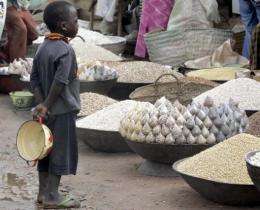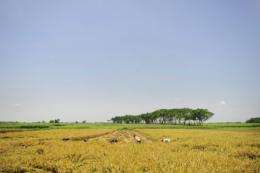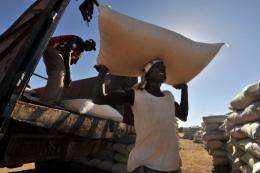Global research chief sees rice boom in Africa

Subsaharan Africa could double or triple rice yields and one day even export to Asia where urban sprawl and rising sea levels threaten paddies, a global research chief said Monday.
Large parts of Subsaharan Africa, in the Sudan, for example, have vast tracts of land suitable for paddy rice production, said International Rice Research Institute director general Robert Zeigler.
But these lands have yet to be harnessed.
As a result, Africa now imports about 40 percent of its rice needs from Asia.
In 2009, paddy production rose 3.44 percent to 24.43 million tonnes in African countries, UN Food and Agriculture Organisation data showed.
But demand grew 4.2 percent in the same year, said the Africa Rice Centre's annual report, forcing the continent to import 10 million tonnes of rice at a cost of $4 billion ($2.8 billion euros).
"We are looking to double or triple the yields in Africa - they are very low now," Zeigler said in an interview in Madrid, where he was picking up a BBVA Foundation award to the institute for development cooperation.

"Within 10 years we will begin to see increases in national production statistics, I don't have any doubt about that," he said.
The International Rice Research Institute (IRRI) plans a "green revolution" in Africa built on improved grains, better infrastructure, basic mechanised farm tools and the development of agricultural research.
In the longer term, demand for rice will carry on growing in Asia but land for paddies is already saturated and it may decline as Asian megacities encroach on farms and Delta areas are swamped by a rising sea and increasingly severe storms because of climate change, Zeigler said.
"If you look at Subsaharan Africa there are areas, very, very large areas that have a lot of land, very good land, that have a lot of water and there are hardly any people who live there," he said.
"These are areas that could be future sources for global food supply," Zeigler said, citing areas in the Sudan, Mali, Senegal, Ghana, and along the Niger Delta.

China was already investing in some of these areas in Africa, he said. Such investments should be properly managed, the research chief said, but not refused.
"It could be that 25 years from now, India and China will be sourcing a significant amount of their staples from Subsaharan Africa," Zeigler said.
"If that is managed properly that could be a tremendous boon to the farmers in Africa, take pressure off land in Asia and if it is done properly everybody wins."
The Manila-based IRRI, which has programmes in Mozambique, Tanzania, Burundi and Uganda, has teamed up with Africa Rice, which is a formal linkage of over 20 Subsaharan countries to push rice output in the continent.
Rice grains in Africa have deteriorated over time, and new varieties are needed with shorter growing seasons and resistance to drought and disease, including the endemic African virus, Rice Yellow Mottle Virus.
But African countries also need to build better roads between farms and markets, and develop water irrigation, which is particularly crucial to rice farming, Zeigler said.
Also, in Africa much of the farming is done by a woman using hoes, often while carrying babies.
In rice farming, where level fields are crucial to proper water distribution, fertilization and impeding weeds, farms will have to start using simple two-wheeled ploughs with small diesel or gasoline engines.
Finally, Africa would have to develop a network of agricultural researchers.
(c) 2011 AFP
















